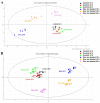A Metabolomics Investigation of the Metabolic Changes of Raji B Lymphoma Cells Undergoing Apoptosis Induced by Zinc Ions
- PMID: 34677404
- PMCID: PMC8540409
- DOI: 10.3390/metabo11100689
A Metabolomics Investigation of the Metabolic Changes of Raji B Lymphoma Cells Undergoing Apoptosis Induced by Zinc Ions
Abstract
Zinc plays a pivotal role in the function of cells and can induce apoptosis in various cancer cells, including Raji B lymphoma. However, the metabolic mechanism of Zn-induced apoptosis in Raji cells has not been explored. In this study, we performed global metabolic profiling using UPLC-Orbitrap-MS to assess the apoptosis of Raji cells induced by Zn ions released from ZnO nanorods. Multivariate analysis and database searches identified altered metabolites. Furthermore, the differences in the phosphorylation of 1380 proteins were also evaluated by Full Moon kinase array to discover the protein associated Zn-induced apoptosis. From the results, a prominent increase in glycerophosphocholine and fatty acids was observed after Zn ion treatment, but only arachidonic acid was shown to induce apoptosis. The kinase array revealed that the phosphorylation of p53, GTPase activation protein, CaMK2a, PPAR-γ, and PLA-2 was changed. From the pathway analysis, metabolic changes showed earlier onset than protein signaling, which were related to choline metabolism. LC-MS analysis was used to quantify the intracellular choline concentration, which decreased after Zn treatment, which may be related to the choline consumption required to produce choline-containing metabolites. Overall, we found that choline metabolism plays an important role in Zn-induced Raji cell apoptosis.
Keywords: apoptosis; cancer; cell metabolomics; metabolomics; zinc ion.
Conflict of interest statement
All the authors have read and agreed to the content of this submission. We also have no conflicts of interest to disclose.
Figures








References
-
- Kocdor H., Ates H., Aydin S., Cehreli R., Soyarat F., Kemanli P., Harmanci D., Cengiz H., Kocdor M.A. Zinc supplementation induces apoptosis and enhances antitumor efficacy of docetaxel in non-small-cell lung cancer. Drug Des. Dev. Ther. 2015;9:3899–3909. doi: 10.2147/DDDT.S87662. - DOI - PMC - PubMed
-
- Schrantz N., Auffredou M.T., Bourgeade M.F., Besnault L., Leca G., Vazquez A. Zinc-mediated regulation of caspases activity: Dose-dependent inhibition or activation of caspase-3 in the human Burkitt lymphoma B cells (Ramos) Cell Death Differ. 2001;8:152–161. doi: 10.1038/sj.cdd.4400772. - DOI - PubMed
Grants and funding
LinkOut - more resources
Full Text Sources
Research Materials
Miscellaneous

